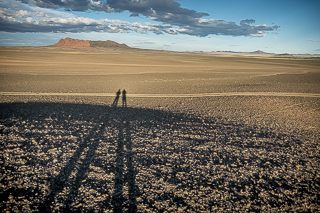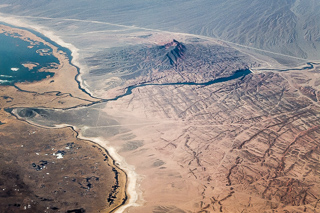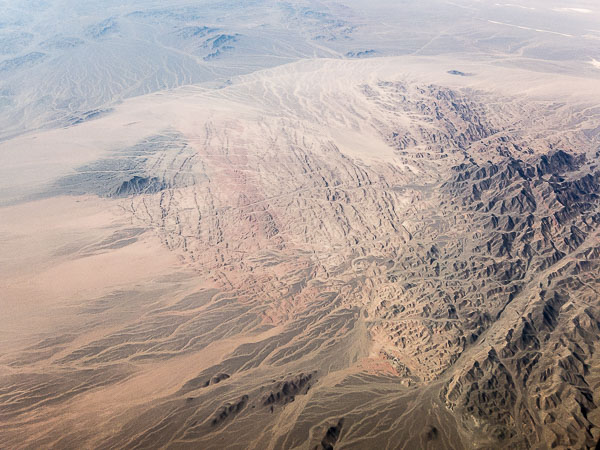Mystery Land

Red and Black Mountain, From Two Miles West
In some ways, the land here was as I had expected from the air—uninhabited and trackless expanses of bare geology that you imagine, but rarely find, in the rest of Mongolia. There is so little traffic on the roads here that litter, common in other parts of the country, is scarce here. During the several hours it took us to replace a wheel bearing and two shock absorbers, there was only one car inconvenienced by the fact that we were working in the middle of the main east-west route. Without surprise, there was no cell phone reception.

Red and Black Mountain From Two Miles Above, 2013
In other places land that seemed cut and sculpted from the air was nearly flat from the ground, the illusion caused by the sorting of sand and gravel by tiny amounts of rain on vast alluvial plains, the last gasp of mountains that have been reduced to hills, on their long eventual journey to the ocean. The view from the ground was of mildly sloping depressions filled with slightly lighter colored sand, between expanses of darker and courser gravel.
On our second night past Uliastai we camped just west of one of the many large protruding rock masses that interrupt the horizon, the remaining origin of so much gravel. We swept enough gravel to pitch our tent on the otherwise flat and vegetation-free ground, and went for a hike to try to get a sense of the land that was so amazing from the air. It is amazing on the ground too, but not for the same reasons. Nowhere can you get a viewpoint to see beyond the next dip or two, keeping the intricate network of erosion we were walking on hidden from our eyes. (You can check the terrain on google maps.)
We planned to make a large loop around western Zavkhan, taking the two main roads shown on the map—the southern route parallel to the Zavkhan River on our way west, the northern route back. But after a flat tire and a suspension problem, Sonoo explained that he would rather return the way we came, which by now he had experience with. Somewhere after we passed the cutoff to the northern route, Sonoo became disoriented and couldn't remember the road we were traveling on from our trip a few days before. We turned around, went back to the cutoff, and he made an attempt to convince us that this was the way we had come. "Ok," I told him, remembering advice we had heard on arguing with drivers about directions.
An hour later Sonoo pulled off the road again with an apologetic look on his face, trying to explain that no, this was not how we had come. By now we must be close to the village of Urgamal, which might even have gasoline for sale. I smiled, made the chopping sign with my open hand, the one that stops when your fingers are horizontal and pointing straight ahead. Sonoo smiled too, and pulled back on the road. We would do the big loop.

